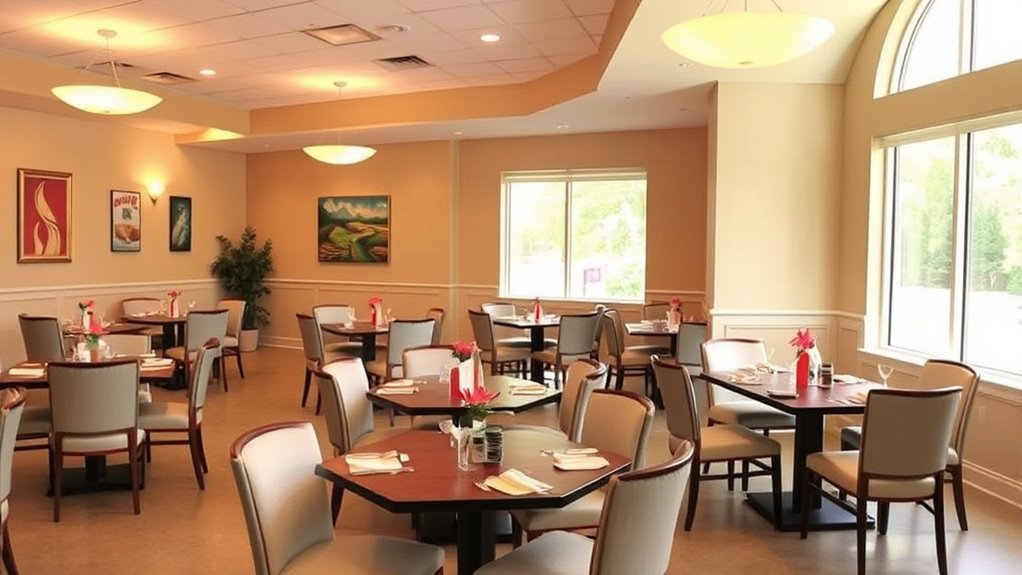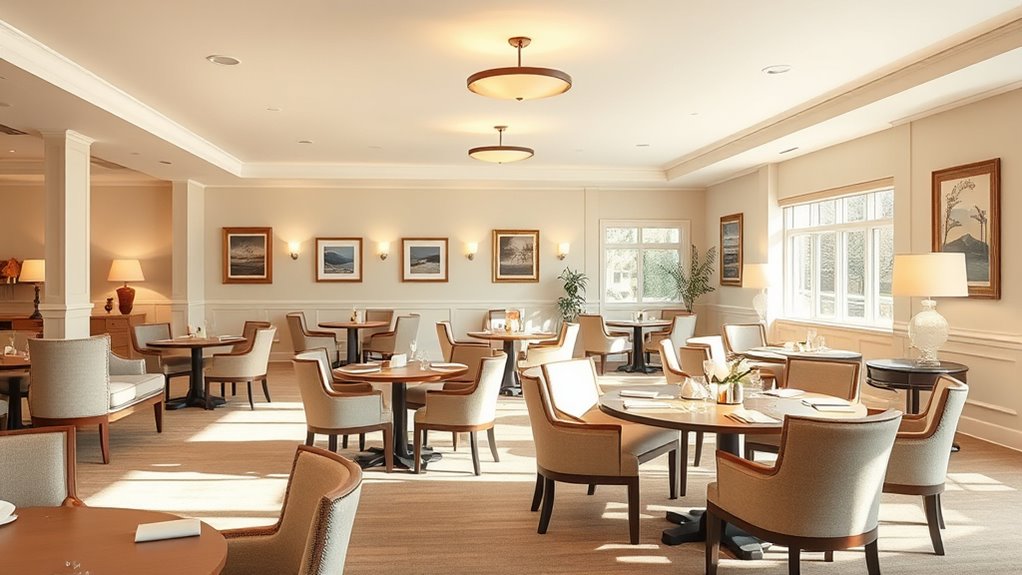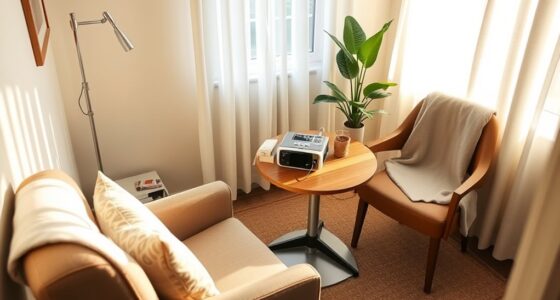To create dementia-friendly dining rooms that boost appetite and preserve dignity, focus on open layouts with clear pathways and visual boundaries to reduce confusion. Use warm, soft lighting and contrasting colors to aid orientation. Arrange furniture to encourage social interaction while avoiding overcrowding, with large, comfortable chairs for support. Minimize noise and distractions to keep the environment calming. If you want to learn more about designing these supportive spaces, keep exploring options that prioritize safety and comfort.
Key Takeaways
- Use open, uncluttered layouts with clear pathways to reduce confusion and promote independence.
- Incorporate natural light and soft artificial lighting to create a warm, calming environment.
- Arrange furniture to encourage social interaction while maintaining sufficient space for easy movement.
- Apply contrasting colors and visual cues to aid recognition and orientation within the dining area.
- Minimize noise and strong odors to prevent overstimulation and support appetite and emotional well-being.

Creating dementia-friendly dining rooms is vital to ensuring that individuals with cognitive impairments feel comfortable and supported during mealtimes. When you design these spaces thoughtfully, you help reduce confusion, promote independence, and improve overall well-being. A well-planned layout considers not only safety but also the emotional comfort of those dining. You want to create an environment where they can focus on eating without distractions or hazards, which can be achieved through strategic placement of furniture, lighting, and visual cues.
Start by choosing a simple, open layout that minimizes clutter and confusion. Narrow pathways and clear visual boundaries help people navigate safely, reducing the risk of falls or disorientation. Avoid overcrowding the room with unnecessary furniture or decorative items, which can overwhelm or distract. Instead, opt for a few large, comfortable chairs arranged to foster social interaction without feeling crowded. Position tables at an appropriate height to make self-feeding easier and more comfortable, especially for those with mobility challenges.
Lighting plays a pivotal role in creating a welcoming atmosphere. Bright, evenly distributed lighting reduces shadows and glare that can cause confusion or anxiety. Use natural light where possible, complemented by soft, warm artificial lighting that mimics daylight. You should also incorporate visual cues to help individuals recognize the dining area easily. Clear signage, colors, or patterns on walls or furniture can act as visual anchors, guiding them to the dining space without frustration.
The arrangement of tables and chairs should promote social interaction while maintaining a sense of privacy. Group tables in small clusters to encourage conversation, but ensure there’s enough space between them for easy movement. Consider placing the dining area in a quiet part of the facility, away from noisy common areas, to reduce overstimulation. Use contrasting colors or patterns on the floor and walls to delineate the dining space clearly, which can help those with visual or spatial difficulties orient themselves better.
Lastly, think about sensory considerations. Soft background music can make the environment more inviting, but it shouldn’t be loud or distracting. Keep the room free of unnecessary noise and strong smells that could cause agitation or reduce appetite. Incorporating visual cues and environmental design can further enhance wayfinding and comfort for individuals with dementia. By designing a space that is visually simple, safe, and calming, you support individuals with dementia in enjoying their meals with dignity. When you pay attention to these details, you create a dining environment that not only encourages eating but also respects their independence and emotional comfort.
Frequently Asked Questions
How Can Lighting Enhance Comfort in Dementia-Friendly Dining Rooms?
You can enhance comfort in dementia-friendly dining rooms by using soft, warm lighting that reduces glare and shadows, creating a calm environment. Adjust lighting levels to match natural daylight, helping residents feel more oriented and relaxed. Guarantee lighting is evenly distributed, avoiding harsh contrasts that can cause confusion or agitation. By thoughtfully controlling light, you promote a soothing atmosphere that encourages appetite and preserves dignity.
What Materials Are Best for Safety and Ease of Cleaning?
You should choose materials like non-slip vinyl or rubber flooring, which prevent falls and are easy to clean. Use smooth, sealed surfaces such as laminated or solid surface countertops that resist spills and stains. Avoid intricate patterns or textured finishes that trap dirt. Opt for washable, antimicrobial fabrics for seating and curtains to maintain hygiene. These choices promote safety, simplify maintenance, and create a welcoming environment for everyone.
How Do Sound Levels Impact Dining Experiences for Dementia Patients?
You’ll find that high sound levels can overwhelm dementia patients, making it hard for them to focus on their meal or enjoy conversation. Excess noise causes stress and may lead to agitation, reducing their appetite and dignity. To improve their experience, keep background sounds at a gentle level, minimize loud noises, and create a calm environment. This supports better dining experiences where they feel comfortable, respected, and able to savor their meals.
What Technology Can Support Meal Assistance and Engagement?
You can use technology like tablet-based apps to guide meal choices and provide visual cues, making dining more engaging. Automated meal delivery systems can guarantee timely service, while voice-activated assistants help residents communicate their needs without confusion. Digital signage and reminders can also promote independence, reducing staff workload. Incorporating these tools creates a supportive environment, encouraging dignity and participation during mealtimes for dementia patients.
How to Involve Residents in the Design Process Effectively?
Think of designing a dining space as planting a garden—you need to nurture ideas from those who’ll use it. To involve residents, hold regular, inclusive discussions, listen actively, and incorporate their feedback into plans. Share sketches or mock-ups to visualize changes, and encourage them to suggest personalized touches. This collaborative approach guarantees the space truly reflects their needs, fostering a sense of ownership and dignity in every meal experience.
Conclusion
Creating dementia-friendly dining rooms isn’t just about comfort—it’s about dignity. Thoughtful layouts can boost appetite and confidence, making mealtime more enjoyable. Did you know that studies show residents in well-designed dining spaces are 30% more likely to eat fully? By prioritizing ease of movement and familiar surroundings, you can truly enhance quality of life. Your efforts can make a meaningful difference, ensuring every meal respects their independence and dignity.









